The Welland Canal
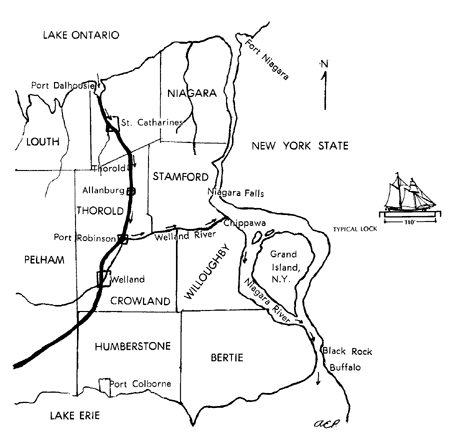
The first Welland Canal
The present Welland Canal, the fourth to be constructed, reflects the evolution of the North American shipping trade during the past 160 years.
The First Welland Canal - 1829-1844
Much of the credit for building the first canal goes to an enterprising businessman, William Hamilton Merritt, of the then Province of Upper Canada. It was the need for a regular flow of water to his mills, coupled with the proximity of the Erie Canal, in the United States, that prompted Merritt to undertake initial engineering studies. In 1824, convinced that the construction of a canal was feasible, he founded the Welland Canal Company which was financed by government and private sources.
The first sod was turned on November 30, 1824, at Allanburg. Today, a commemorative cairn located at the west end of Bridge No. 11 marks the location of that historical event. The Welland Canal Company pressed on with the gigantic tasks of earth excavation and marine construction, made so much more arduous by the limited tools available at that time. Five years later, the schooner "Ann and Jane" completed the first upbound transit, a two-day voyage.
Wherever possible, natural waterways became part of the canal. From Port Dalhousie, on Lake Ontario, the canal followed the route of Twelve Mile Creek through St. Catharines to Merrritton, and up the escarpment to Thorold. In those early years of operation, the canal terminated 8 km (5 miles) south of Thorold, at Port Robinson on the Welland River. Ships then proceeded east on the Welland River to Chippawa, and continued up the Niagara River to Lake Erie.
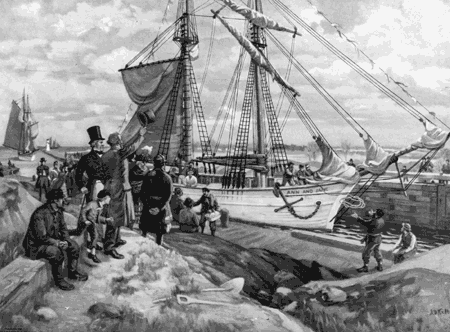
This painting by J.D Kelly was commissioned by Confederation Life Association. The schooner "Ann and Jane" is shown entering Lock One, at Port Dalhousie when the Welland Canal opened on November 30, 1829.
As traffic increased, the canal was extended directly to Lake Erie from Port Robinson in order to avoid the strong currents of the Niagara River. Gravelly Bay, now Port Colborne, was made the southern terminus of the new 18 km (11-mile) cut. Completed in 1833, the first Welland Canal was 44 km (27 miles) long. There were 40 wooden locks with a minimum size of 33.5 m by 6.7 m (110 x 22 feet) and a depth of 2.4 m (8 feet).
The maintenance of hastily constructed wooden locks proved expensive for the Welland Canal Company and toll revenues were not sufficient. Appeals were made for additional government assistance and, in 1839, the Government of Upper Canada voted to purchase the privately held company stock.
The Second Welland Canal - 1845-1886
The purchase of the Welland Canal Company was completed shortly after the Union of the Provinces, in 1841, and soon thereafter plans were drawn for an improved Welland Canal. Plans were also made for canals and locks of similar dimensions in the St. Lawrence River to provide a direct water route from Montreal to the interior and thus join Quebec and Ontario.
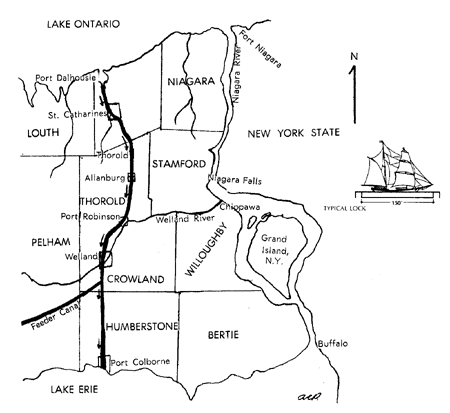
The second Welland Canal
Work began to increase the canal depth to 2.7 m (9 feet) and to reduce the number of locks to 27. The new locks were masonry structures 45.7 m (150 feet) long and 8.1 m (26.5 feet) wide. The route of the new canal was much the same as that of the first since the channels and locks of the original canal became the control weirs of the new works.
Concurrently, a canal of similar depth was completed between Montreal and Lake Ontario and, by 1848 navigation with a draft of 2.7m (9 feet), was possible from Lake Erie to the lower St. Lawrence River. By that time, steamers had begun to replace sailing vessels; they were larger ships and their number was increasing rapidly. In 1870, a Government-appointed Commission recommended canal improvements. Its report stated that "wheat, lumber, copper and iron from the Upper Lakes would pass though the Welland Canal in increasing amount were it not for the fact that the larger boats cannot go through". The report further pointed out that the existing locks could not handle three quarters of the tonnage that could come from the Great Lakes hinterland.
The Commission's recommendations gave rise to the construction of the third Welland Canal and related improvements on the St. Lawrence River.
The Third Welland Canal - 1887-1931
The third Welland Canal played an important role in the development of Canada's grain export trade and its steel industry. Following the same route as the second canal from Lake Erie to a point 5 km (3 miles) above the escarpment, it then left Twelve Mile Creek and followed a more direct line to Port Dalhousie.
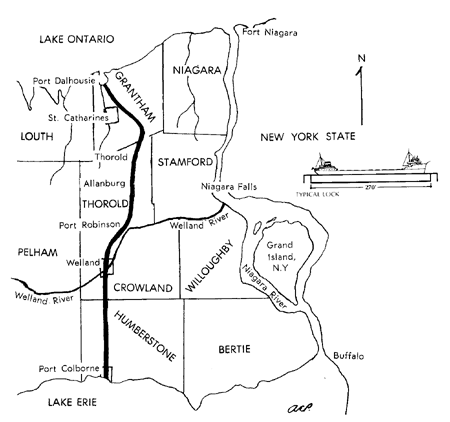
The third Welland Canal
(Maps believed to be copyright 1970 by Allan Pritchard)
There were now 26 cut stone locks, each 82.3 m (270 feet) long and 13.7 m (45 feet) wide. Originally, the limiting depth was to have been 3.7 m (12 feet) but it was increased to 4.3 m (14 feet) during construction. These new works were partially opened in 1881 but it was not until 1887 that the 4.3 m depth was available throughout. In 1889, nearly 2,000 vessel transits were recorded, 820 by steamships and 1,141 by sailing vessels.
A distinctive type of vessel was developed for use in the inland canal system. The Great Lakes "canaler", a bulk carrier that is literally a self-propelling barge, with machinery at the stern and navigating bridge up forward, had a long, almost box-shaped cargo hold between. The "canalers" using the third canal had a maximum length of 79.9 m (262 feet) and could carry as much as 2 700 tonnes (3,000 tons).
Larger ships were also built to sail from the Lakehead (Lake Superior) to Port Colborne where their 13 500 tonnes (15,000 tons) of cargo were transferred to several small "canalers". However, it soon became evident that these larger vessels should be able to move into the lower lakes and, between 1907 and 1912, plans were made for enlarging the canal once more.
The Fourth Welland Canal
Studies led to the decision to build locks of greater size and to reduce their number as much as possible. An almost direct north-south route was selected and the Lake Ontario connection was moved to Port Weller, 5 km (3 miles) east of Port Dalhousie. Since no natural harbour existed at Port Weller, an artificial one was created with embankments extending 2.4 km (1.5 miles) into Lake Ontario.
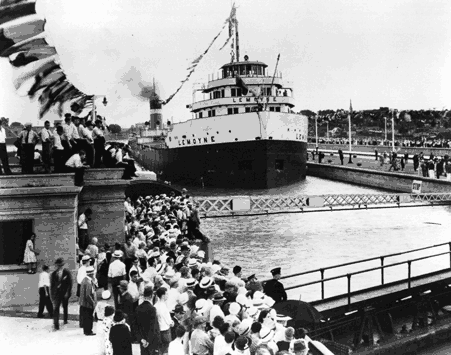
The opening of the fourth canal, 8 August 1932
Construction of the canal started in 1913, was interrupted by World War I, resumed in 1919 and continued until 1932.
"It is a privilege to dedicate this canal to the trade of the world. I hereby declare the Welland Canal open to the commerce of the world." Those were the words of the Governor General of Canada, the Rt. Hon. Earl of Bessborough, as he officially opened the canal, on August 6, 1932.
Into the lock chamber eased the S.S. LEMOYNE, then the largest freighter on the Great Lakes. Her holds were filled with some 19 000 m3 (530,000 bushels) of wheat. The S.S. LEMOYNE was 192.9 m (633 feet) long, had a beam of 21.3 m (70 feet) and was sailing that day on a draft of 5.9 m (19.5 feet).
